#But cotton-linen vs cotton vs polyester
Explore tagged Tumblr posts
Photo
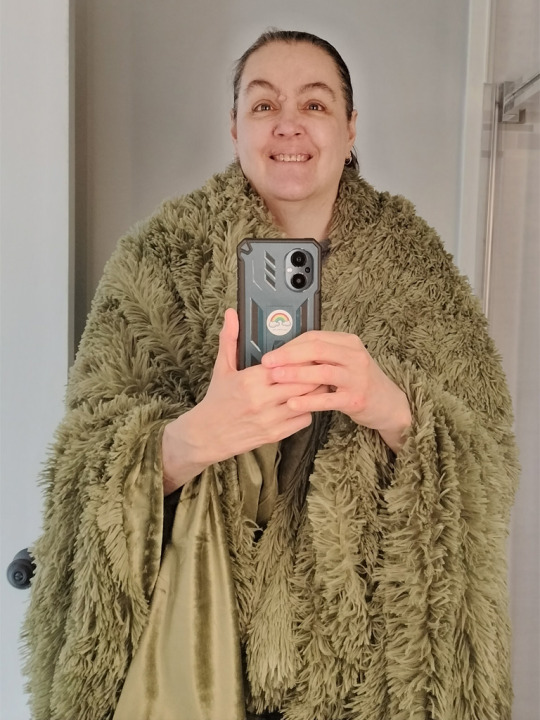
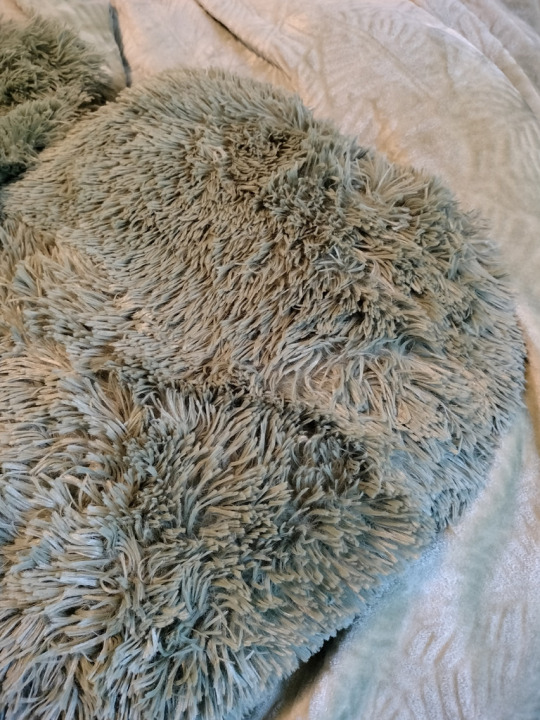
Less than 48 hours since ordering and the shaggy comforter cover set has already arrived. In the second image you can see how much darker this actually-sage-green thing is than the supposedly-sage-green fuzzy blanket. Also the colour difference between artificial light (left) and sunlight (right).
Shaggy thing (which looks amusingly and mildly distressingly like I bagged and skinned a very large muppet for its fabric) is still perking up from being compressed during shipping. I’ll probably run it through the dryer on low heat cycle to fluff it up properly (and blow off any loose bits of fibre) before using it. I figure if I don’t insert a comforter in it, I can get some use out of it as an extra-thick and fluffy blanket before it goes into storage until next fall.
Meanwhile the sheet set only just finally set out from Salt Lake City in the US southwest yesterday. The quilt set should be arriving tomorrow. The two remaining pillows (coming from China) passed through Toronto on Monday, so they could probably arrive here any time from now until Friday.
So unless the sheet set makes a super-fast journey it’ll probably be some time next week before I can put everything together on the bed. Even so, I am excite.
#Moss Bed#I am so looking forward to using all this new bedding#It's going to be stupidly cute once it's all put together#I still want to get some more throw pillows for it#And an amanita mushroom plushie#But they can wait#I already spent more than originally planned on this#The sheet set I liked most was about twice the price of the next cheapest option#(Four times the cheapest option)#But cotton-linen vs cotton vs polyester#And I already had most of it on order before deciding#That I really should get a quilt in the same sage green colour range#Because my existing green quilt is not in the right range or saturation level#And would stick out like a sore thumb#Man I love being able to splurge once in a while#Instead of (sometimes literally) counting pennies for every purchase
7 notes
·
View notes
Text
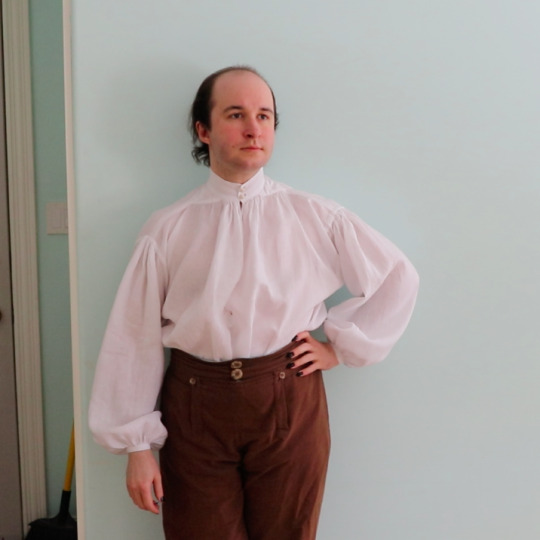
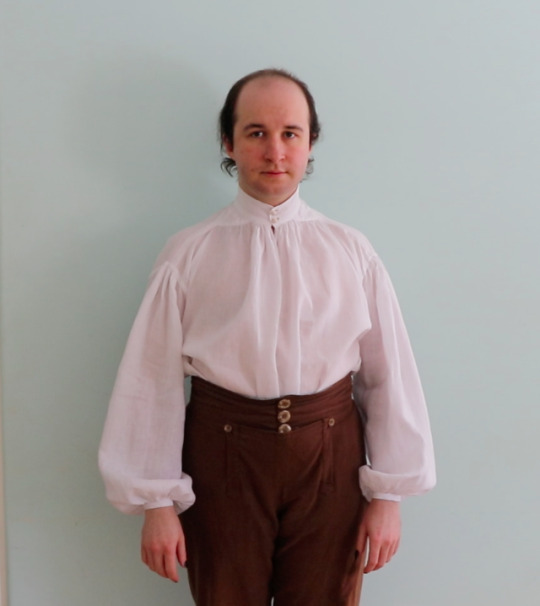
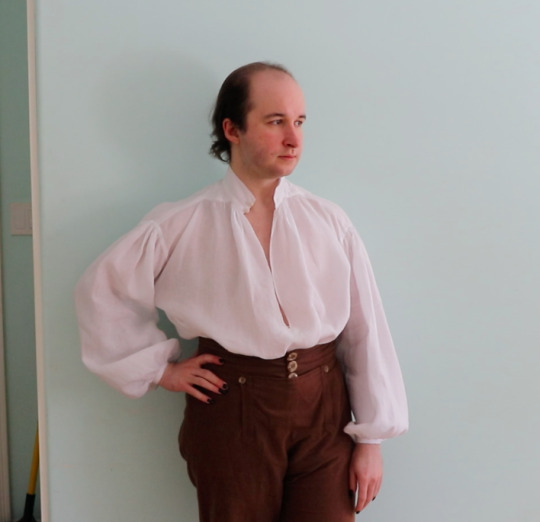

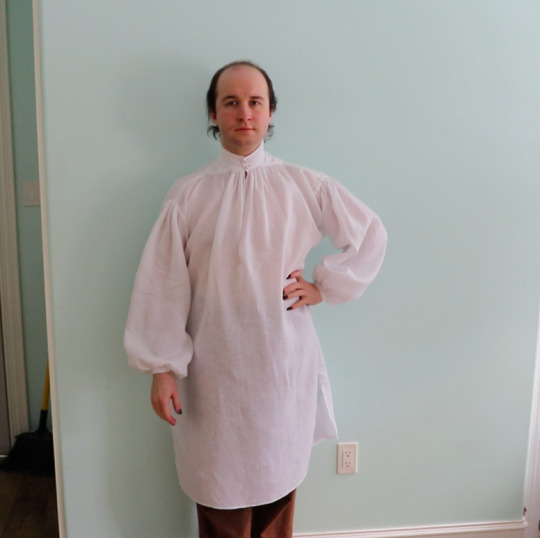
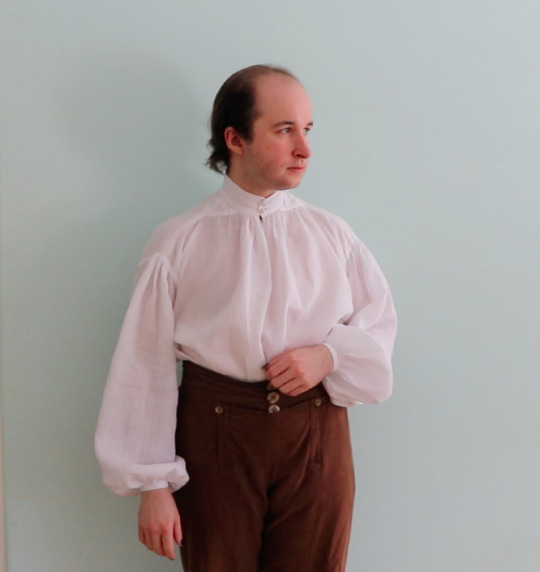
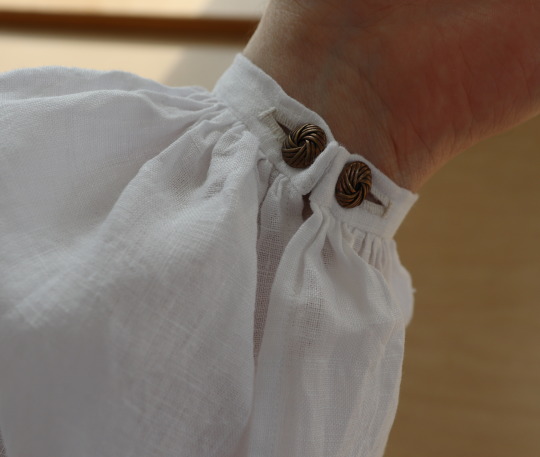
Oh, right, I meant to post some more pictures of the shirt I finished 2 weeks ago. It's not very different from my other white linen shirts, except for the fact that it's mostly machine sewn. I'd like to make more machine sewn white shirts, because I don't like to wear my 100% hand sewn ones for everyday too much, it wears them out too quickly. (I've had a few wear to rags without ever getting the chance to be in a nice historical photoshoot.)
I think part of the reason I hadn't machine sewn very many fine white linens before this is because I didn't have a good thread to use on them. Polyester thread is alright for the coloured ones, but I don't like to use it for white, and the only cotton thread I had was unpleasantly stiff. (Silk works, but it's expensive and I find it wears out too quickly in shirt seams.) But I recently bought a nice big spool of Aurifil 50 weight cotton thread and it's so nice and fine! Perfect for this sort of thing!
This shirt has hand finishing on the inside of the collar & wristbands, thread buttons and buttonholes by hand, and the bar tack at the bottom of the front slit is by hand as well.
I think the most visible difference in the machine sewn shirts vs. the hand sewn ones is the gathers. The hand sewn gathers on 18th century shirts are done from the outside with a whipstitch and it makes them so nice and perfect and even, and doing the machine sewn ones like a normal seam and pressing them open never looks as good, no matter how carefully I arrange the gathers. But it's ok for an everyday shirt.
I have no idea where the linen is from, since the several pieces of fine white linen in my stash don't have many distinguishing features.
341 notes
·
View notes
Text
wasnt going to do it this year but someone requested so here it is
(my biggest out is probably cultural shift/trend explanation/obsessed with the current "moment" which includes in and out lists lol)
In
Side bangs
Photography/collage will be back in a big way
Warm lighting in photos/digital SLR style ( think night time street lights)
^A “Going home to the suburbs from college during winter break” nostalgia vibe
Houndstooth print
Chunky knit sweaters
Wool, cotton, etc, real fibers
“Classic” style, pea coats, long skirts, Basque waist dresses. petticoats, silk robes
Clothes that are about fit and movement of fabric/“timeless”
Velvet and metallics
Deep colors
“late 2000s/early 2010s does French new wave” style also back
Cotton leggings (french new wave-NON athleisure)
Long and not boxy shirts
Wedge shoes
Big sunglasses
The pre-trump 2010s
Collecting things/trinkets/ stoneware plates etc
Horseshoes/pressed tin ornaments/cozy eclectic decoration
Antique stores
interesting noses/roman noses
Frizz/wild hair
Striped and plaid high back couches
Striped linens
Delicate wallpaper patterns
tile
Early 1900s bohemian poet or painter interiors
A bit of moroccan/“global” eclectic mom style
Reading middlemarch
reading letters/diaries
golden age of Hollywood interest
Vermouth spritz
collecting/watching DVDs and CDs
programmed TV vs streaming
uyghur food
Out
Painting is on the decline as a trendy art
Cropped shirts
Polyester/synthetics/mesh/smocked back dresses
Gaudy prints
White kitchen cabinets with gold or black hardware
Mid century modern furniture
Luxury / “Clean”
Martini/going out to a fancy restaurant to take pictures culture (now cringe)
Edgelord ,as the "edgy" part no longer applies under a second trump presidency
Essays
Cultural shift/trend explanation essays and videos
pop psychology
poptimism
Tik tok voice
bright/garish clothes colors and garish prints
gothy/"grunge"
Instagram face/nose
lip fillers/lip overlining seen as gauche
Athleisure
This is the year where Y2k is truly OUT in place of the Obama years
“Bitchyness” also out, that was a reflection of bush years nostalgia
Too much skin care/make up. now seen as damaging to skin
Twitter
23 notes
·
View notes
Note
im curious whenever you share anything about different abilities of different fabrics; if it's something you'd be interested in talking about, could you explain why applied printing is easier on polyester? is it because of the slippery texture, or how the fabric is manufactured, or something else?
Sublimation is a weird process. The dye transforms into a gas when heat is applied to it which opens up the garment's fibers. With synthetic fibers the two substances can form a chemical bond but with cotton or other natural materials, even though they can be very absorbent but there is no chemical process to keep the dye adhered to the cotton so the dye will just wash out.
To make the sub print adhere to the cotton it has to be sprayed with a chemical coating that will allow for the chemical bond to form. So, in theory we could do it, but we would have to use a chemical to achieve this process and I believe it is that chemical that is not eco-friendly.
Our factory is GOTS certified and holds several other environmentally friendly certifications and when we asked about sub printing on cotton, they said no because of the chemical that would be involved. I believe it would go against their internal policies, and in my mind, it would invalidate the whole point of having natural fibers if we were just going to spray them with some terrible chemical compound.
What we can do for the natural fibers, such as cotton on linen, is just regular dying and printing, but that has to take place in a straight line. They would be printing a repeating pattern on a roll of fabric for us at that point. Which we are debating doing for other products. This is why all over prints (AOP) are easier to do on natural materials vs things like the hem designs. In theory hem designs can work but it will take a lot more templating and finagling to get this right.
68 notes
·
View notes
Text
I just queued up a post about sustainable fabrics and started to write something in the tags before realizing that it was drifting away from the point
but PSA: with the caveat that the most sustainable item of clothing is the one that's already in your closet, I would suggest that if you are someone who struggles with temperature regulation, you should seriously consider adding more linen and wool to your wardrobe. determining the "true" environmental impact of various fibers is v complicated, but for a start they both use significantly less water than conventional cotton, and imo the improvement they've had on my quality of life is well worth the substitution.
linen and wool are by far the best fabrics for temperature regulation--the former is lighter and more breathable than cotton and will keep you cooler in the summer, the latter is breathable but heavier and more insulating and will keep you warmer in the winter, even if it gets wet. (there's actually a saying among people who hike/do winter sports that "cotton kills" because you are more prone to hypothermia in cotton undergarments than in wool.) do not even get me started on linen/wool vs polyester.
this is something that I think is especially important given higher cost of heating lately, higher temperatures due to climate change, and the number of people who have health conditions or medications that make them sensitive to heat. this isn't to say that your clothing/bedding choices will compensate for a livable environment, but as someone who used to wake up 2-3 times a week sweating in synthetic sheets for four months of the year, and shiver in an inadequately heated room for another three, these little swaps can seriously make extreme temperatures a little more bearable.
that being said, wool and linen do tend to be more expensive, so if you're looking to get the most bang for your buck, I would recommend starting with:
linen sheets, even just a fitted sheet (some companies do sell them solo). overheating while sleeping is literally the worst.
linen pants, especially if you work in a job that doesn't allow you to wear shorts. linen shirts are also nice, but even cotton/poly shirts tend to be thinner than pants and might already be short-sleeved/you can roll up the sleeves, so the impact of pants will be more immediate.
a chunky wool sweater. avoid cashmere, and merino unless it has cables--these are very soft, lovely wools, but they're generally pretty light and made more for their softness than their insulation properties. for maximum warmth, you don't want a thin "office sweater," you want a "my Irish gran knit this in her cottage on the windy coast" sweater.
wool socks. these are more likely to keep you dry and warm if you're walking through slush or rain, in addition to just general walking-around-the-house warmth. for these I would say the type of wool matters a little less, generally because you do want socks that are somewhat lightweight so you can wear them in shoes. and just FYI you're also more likely to see wool socks blended with silk, nylon, or spandex for strength and elasticity, so don't drive yourself up the wall trying to find the mythical 100% wool sock. even hobby knitters tend to blend wool with something because of the amount of friction that wears on socks.
again! the most sustainable type of clothing is what you already own. but some of these are the kinds of small swaps you can definitely make over time, and you might find them genuinely helpful.
49 notes
·
View notes
Note
As someone who can't wear fabrics that are itchy, (rough) even if it washed in softener. Can you give advice on what to look for? I need more business clothes but it seems all the work pants I find for the office is made of that fabric.
Oh this is a tough one. Unfortunately, you might have to go for a higher price point. A fix that worked for an actress I used to work with was wearing satiny cuddl duds in the winter and tights in the summer under all of her pants but YMMV.
(this next part assumes you're US American but I think the idea is applicable everywhere)
First, I would recommend going a slightly fancy department store like Nordstroms. You don't have to buy anything, just feel some clothing to figure out what fabrics you like and write it down. I would recommend going to a higher end store vs like JC Pennys because manufactures like to lie about fabric content and in my personal experience it's less of an issue if you go to a more expensive store. If you're like me, anything rayon, wool, or polyester is a no-go. Semi synthetic fabrics are hit or miss. I'm personally good with silks, satins, linens, and cottons. (If you're not allergic to wool, apparently merino wool is great)
If you're close to a bigger city, you'll probably be good to shop in store. Smaller towns you'll probably have to do online shoping in order to avoid certain fabrics. I haven't shopped at all these but off the top of my head some good stores to check out might be: Quince, Universal Standard, Good American, Amour Vet, Madewell, and Macy's but be real vigilant about checking the fabric content. Rich People Goodwill can have some great stuff but with the rise of thrifting it can be a slog (and real frustrating depending on your size)
May the odds be in your favor on the hunt for non scratchy clothes <3
79 notes
·
View notes
Text
A Spiritual Lesson from Torah.

In 2003, a Jewish doctor named Heidi Yellen conducted a study on the frequencies of fabric.
According to this study, the human body has a signature frequency of 100, and organic cotton is also the same. The study showed that if the number is lower than 100, it actually puts a strain on the body. A diseased, nearly dead person has a frequency of about 15, and that is where polyester, rayon, and silk register. Nonorganic cotton registers a signature frequency of about 70.
Even wearing a wool sweater on top of a linen outfit in a study collapsed the electrical field. The reason for this could be that the energy field of wool flows from left to right, while that of linen flows in the opposite direction, from right to left.

The frequency stuff sounds good. But a spiritual lesson is in here from the Torah. All Scriptures should be read in context. If not read in context it becomes a pretext.
According the Scriptures certain mixtures should be avoided (Lev 19:19). Prohibitions against mixing together things which are separated in God’s creation and spiritual laws.
Deu 22:11 'Thou dost not put on a mixed cloth, wool and linen together.
Wool vs linen. Animal vs vegetable. Fleshly desires vs divine righteousness.
Linen used of Divine righteousness (Rev_19:8), and not to be mixed with animal or fleshly labour (works of the flesh).
Gal 5:17 For the flesh lusts against the Spirit, and the Spirit against the flesh. And these are opposed to each other, so that you do not do what you desire to do.
Gal 5:18 But if you are led by the Spirit, you are not under Torah.
Rev 19:8 and there was given to her that she may be arrayed with fine linen, pure and shining, for the fine linen is the righteous acts of the saints.'
3 notes
·
View notes
Text
Shopping for clothes really is just like WHO WOULD WIN: polyester cardigan that hermetically seals all your pores vs. cotton and/or linen blouse that wrinkles if you look at it too hard
9 notes
·
View notes
Text
Now that I’ve replaced most of my clothes with cotton or linen & I’m accustomed to wearing clothes comfortably vs wanting to rip them off my skin at the earliest opportunity I’ve noticed I’m much more sensitive to synthetics. I’ve been kicking my body pillow (which had a polyester pillowcase) off my bed in my sleep, so I replaced it with a cotton one that’s much more pleasant. I have 1 dress that I adore the cut of so I’ve kept it despite my recent enlightenment about this sensory issue, but I wore it to work on Friday after the hike bc I thought it would be lightweight & cool after hours in the sun but nope, I wanted to pull it off for the rest of the day while on my feet mingling with faculty & staff, which was disheartening.
I wish I could commission someone to make the same dress out of linen or cotton but even if that were financially reasonable I wouldn’t even know where to begin finding someone with that skillset lol. Anyway, my closet looks comparatively empty when I think back to the before of this whole venture, but I can honestly say I love wearing everything that’s left & wear all of the remaining clothes quite often.
#me#I saw a linen dress in the store a while back but they were out of my size#today while I was putting up my laundry I decided to check the website &!#lo & behold it was on massive sale due to the end of summer quickly approaching#so I ordered it & felt pretty justified bc my wardrobe is pretty light#& it’s hard to find things I like in the material I need to feel comfy#with winter approaching I’ll probably need to replace some amount of warm clothes with wool or thick knit cottons#& I need some leather boots I can wear to work that won’t be slip prone on ice#I think I can sell my old leather boots to help with the replacement cost#they were fine for Texas but they’re slick as a baby’s ass on the bottom#so every time there’s ice (6 months of the year) I nearly die#or bruise my ass#but I got some great canvas alpaca & leather coats last seasons#so I’m getting there with winter clothes too
17 notes
·
View notes
Text
Embrace Sustainable Fashion with Natural Fabrics

In today’s fast-paced world, fashion is everywhere. As we embrace the latest trends, many of us are looking for more than just style and affordability — we're prioritizing the planet too. 🌍✨ One of the best ways to make a positive impact is by choosing natural fabrics for our clothing.
🌱 What are Natural Fabrics? Natural fabrics come from plants, animals, or minerals. Each type has unique properties, benefits, and ideal uses. From the airy softness of cotton to the luxurious drape of silk, these fabrics offer something special for every wardrobe.
Here are some common types of natural fabrics:
Cotton: Breathable and comfortable, cotton is a favorite for everyday wear. Think T-shirts, jeans, and more.
Silk: Luxurious and hypoallergenic, silk is perfect for eveningwear and bedding.
Wool: Known for its insulation, wool keeps you warm in the winter months.
Bamboo: Soft and breathable, bamboo is gaining popularity for its eco-friendliness.
Linen: With moisture-wicking properties, linen is the go-to fabric for warm weather.
🌿 Why Choose Natural Fabrics? Here are some key reasons to go natural with your wardrobe:
Biodegradability: Natural fabrics break down easily, reducing landfill waste and pollution, unlike synthetic fabrics which take centuries to decompose.
Breathability: Natural fibers allow air to circulate, keeping you cool and comfortable — especially in hot and humid climates.
Skin-Friendly: Hypoallergenic and free of harsh chemicals, they are perfect for sensitive skin.
Chemical-Free: Fewer chemicals and synthetic additives mean less exposure to harmful substances.
Aesthetic Appeal: Natural fabrics often have a beautiful, natural luster and texture, giving you a timeless, elegant look.
✨ Natural vs Synthetic Fabrics: While synthetic fabrics like polyester and nylon are engineered for performance, they come at a cost to the environment. Synthetic fibers take hundreds of years to break down and often lack the breathability and eco-friendliness of natural fabrics.
So next time you shop, consider natural fabrics. They’re better for your skin, better for the planet, and just as stylish!
3 notes
·
View notes
Text
How to Choose The Right Tuxedo For Different Events

How to Choose The Right Tuxedo For Different Events
Tuxedos are a classic and sophisticated choice for formal events, but choosing the right one can be a challenge. The right tuxedo will not only make you look great, but it will also ensure that you are dressed appropriately for the occasion. Here are some tips for choosing the right tuxedo for different events.
Black Tie: For a traditional black tie event, choose a black wool tuxedo with a shawl collar and a single-button closure. The jacket should have satin-faced lapels and a matching black satin stripe down the outside of each pant leg. Black patent leather shoes and a black bow tie are also essential for this classic look.
White Tie: For a white tie event, choose a full-dress tailcoat with a black wool tailcoat, black silk trousers, and a white wing-collared shirt. A white bow tie, black patent leather shoes, and white gloves complete this formal look.
Creative Black Tie: For a more modern take on the classic black tie, choose a tuxedo with a unique jacket design or a colorful bow tie. Experiment with different textures and materials, such as velvet or silk, to add a touch of personality to your outfit.
Semi-Formal: For a semi-formal event, choose a dark colored tuxedo, such as navy or charcoal, and pair it with a classic white dress shirt and a black bow tie. A vest or cummerbund can also be added for a pop of color.
Destination Wedding: For a destination wedding, opt for a lighter weight tuxedo in a lighter color, such as cream or light gray, to accommodate for the warm weather. A linen or cotton tuxedo can be a great choice for this type of event.
In conclusion, choosing the right tuxedo for a formal event is all about understanding the dress code and finding the perfect balance between style and appropriateness. With these tips, you'll be sure to look your best at any formal event.
Tuxedo Accessories: Ties Vs. Bows
When it comes to accessorizing a tuxedo, the choices often come down to ties versus bows. While both are popular options, each has its own unique style and benefits that make it the right choice for certain occasions. Here’s a guide to help you choose between the two.
Ties: Ties are a versatile option for formal events. They come in a wide range of colors and patterns, making it easy to find one that matches your personal style and the event’s dress code. Ties can also be made from different materials, including silk, satin, and polyester, which can affect the look and feel of the tie. For a more traditional look, opt for a black silk tie. For a more modern look, choose a tie in a bold color or pattern.
Bows: Bow ties are a classic choice for black tie events. They add a touch of sophistication and elegance to a formal outfit and are an excellent way to showcase your personality. Unlike ties, bow ties come in a limited range of colors and patterns, but they are all timeless and classic. They are also more difficult to tie than regular ties, so consider hiring a professional to help you get the perfect knot.
When choosing between ties and bows, consider the dress code of the event and your personal style. If the dress code is strict and requires a traditional look, a bow tie may be the way to go. If you want to add some personality to your outfit, a tie may be the better choice.
the choice between ties and bows is a personal one. Whether you prefer the versatility of a tie or the timeless elegance of a bow, both options can add the perfect touch of sophistication to a tuxedo. Whichever you choose, be sure to wear it with confidence and enjoy the occasion.
Your Tie Adds Class To Your Tuxedo
Ties are one of the most important accessories for men, and there are many different tie models to choose from. Whether you’re looking for something to wear to a formal event or just a casual day out, there’s a tie for you. Here are some of the most popular tie models to help you make the right choice.
The classic four-in-hand tie is the most common type of tie. It’s a slim, narrow tie that’s usually made of silk or other fine fabrics. The four-in-hand tie is usually worn with a suit and is the most versatile type of tie. It’s also the most affordable option.
The Windsor knot is a larger and more formal tie than the four-in-hand. It’s typically made of a thicker fabric, such as wool or silk, and is usually worn with a suit. The knot is also larger and is often used for special occasions.
The bow tie is a type of necktie that is tied in a bow shape. It’s usually made of silk or other fine fabrics and is usually worn with a suit. Bow ties are often seen as a more formal option and are usually worn with a tuxedo.
The ascot tie is a type of necktie that is tied in a loop around the neck. It’s usually made of a thicker fabric, such as wool or silk, and is usually worn with a suit. The ascot tie is a more formal option and is often seen at formal events.
The necktie is a type of necktie that is tied in a knot at the neck. It’s usually made of a thicker fabric, such as wool or silk, and is usually worn with a suit. The necktie is a more formal option and is often seen at formal events.
The cravat is a type of necktie that is tied in a knot at the neck. It’s usually made of a thicker fabric, such as wool or silk, and is usually worn with a suit. The cravat is a more formal option and is often seen at formal events.
2 notes
·
View notes
Text
Best Fitted Bed Sheets
Fitted bed sheets are an essential part of modern bedding, offering practicality, comfort, and style. Unlike flat sheets, fitted sheets are designed with elastic edges that fit snugly around your mattress, staying in place throughout the night. In this article, we’ll explore everything you need to know about fitted bed sheets, including their features, types, benefits, and how to care for them.
Table of Contents
What Are Fitted Bed Sheets?
Why Are Fitted Bed Sheets Important?
Key Features of Fitted Bed Sheets
Types of Fitted Bed Sheets
Advantages of Fitted Bed Sheets
1. Easy to Use
2. Wrinkle-Free Appearance
3. Longevity
How to Choose the Right Size
Standard Mattress Sizes
Tips for Accurate Sizing
Caring for Fitted Bed Sheets
Washing and Drying Tips
Preventing Shrinkage and Damage
Common Issues with Fitted Sheets
Slipping Off the Mattress
Stretched or Torn Elastic
Sustainable Options for Fitted Sheets
Eco-Friendly Materials
Styling Ideas for Fitted Sheets
Matching Bedding Sets
Patterns and Textures
Where to Buy Fitted Bed Sheets
Retail Stores vs. Online Shopping
Trusted Brands
Budget-Friendly Options
Premium Fitted Sheets
Frequently Asked Questions (FAQs)
1. How Do I Keep My Fitted Sheet in Place?
2. Can Fitted Sheets Be Used on Adjustable Beds?
3. What Is the Best Material for Fitted Sheets?
4. How Often Should I Wash My Fitted Sheets?
5. How Do I Prevent My Sheets from Shrinking?
6. Are Fitted Sheets Compatible with All Mattresses?
What Are Fitted Bed Sheets?
Fitted bed sheets are bedding essentials that come with elasticated corners to hold them securely to your mattress. They are designed to stay in place, even if you toss and turn while sleeping. This eliminates the hassle of constantly adjusting your sheets and ensures a clean, wrinkle-free bed.
Why Are Fitted Bed Sheets Important?
Neat and Clean Look: Fitted sheets create a polished, hotel-like appearance.
Comfort: Their snug fit prevents the sheet from bunching up, ensuring a smooth surface for better sleep.
Ease of Use: Unlike flat sheets, fitted sheets are easier to put on and don’t require constant readjustments.
Key Features of Fitted Bed Sheets
When shopping for fitted bed sheets, understanding their key features can help you make the best choice.
Elasticated Edges
The elastic sewn into the corners or along the edges allows the sheet to wrap securely around the mattress, preventing it from slipping.
Material Options
Fitted bed sheets are available in various materials, such as:
Cotton: Soft, breathable, and durable.
Linen: Lightweight and suitable for warm climates.
Microfiber: Affordable and wrinkle-resistant.
Bamboo: Eco-friendly, moisture-wicking, and soft to the touch.
Thread Count and Texture
Higher thread counts (300 and above) offer a softer, more luxurious feel, while lower thread counts are lightweight and breathable. Choose a texture that aligns with your comfort preferences.
Types of Fitted Bed Sheets
Fitted sheets cater to various preferences and needs, with different fabrics and styles available.
Cotton Fitted Sheets
Cotton is a popular choice due to its breathability and durability. Egyptian cotton, in particular, is known for its premium quality.
Linen Fitted Sheets
Linen offers a casual, relaxed vibe and excels in hot climates due to its natural cooling properties.
Microfiber and Polyester Options
These synthetic materials are affordable, lightweight, and wrinkle-resistant, making them ideal for busy households.
any story
Advantages of Fitted Bed Sheets
1. Easy to Use
The elasticated design ensures that fitted sheets are easy to put on and stay in place without effort.
2. Wrinkle-Free Appearance
Fitted sheets provide a smooth, professional finish, enhancing the overall look of your bed.
3. Longevity
High-quality fitted sheets last for years with proper care, offering great value for your investment.
How to Choose the Right Size
Standard Mattress Sizes
Fitted sheets come in sizes such as Twin, Full, Queen, King, and California King. Always match the size of your sheet to your mattress dimensions.
Tips for Accurate Sizing
Measure the width, length, and depth of your mattress, especially if you use a mattress topper. Choose fitted sheets with deep pockets if your mattress is thicker than average.
Caring for Fitted Bed Sheets
Washing and Drying Tips
Use mild detergent to prevent damage to the fabric.
Wash in cold or lukewarm water to preserve color and elasticity.
Avoid over-drying in the machine, as this can weaken the elastic.
Preventing Shrinkage and Damage
Air dry when possible, or use a low-heat setting on your dryer. This minimizes shrinkage and extends the life of your sheets.
Common Issues with Fitted Sheets
Slipping Off the Mattress
If your fitted sheet keeps slipping off, ensure you’re using the right size. Sheets with deep pockets or added elastic straps can help keep them in place.
Stretched or Torn Elastic
Replace sheets with damaged elastic or repair them by sewing in new elastic bands.
Sustainable Options for Fitted Sheets
For environmentally-conscious shoppers, there are plenty of sustainable fitted sheet options.
Eco-Friendly Materials
Look for sheets made from organic cotton, bamboo, or Tencel. These materials are biodegradable and produced with minimal environmental impact.
Styling Ideas for Fitted Sheets
Matching Bedding Sets
Coordinate your fitted sheets with pillowcases and duvet covers for a cohesive look. Neutral colors like white, beige, or gray are timeless, while bold colors can add personality.
Patterns and Textures
Experiment with stripes, florals, or geometric patterns to create an inviting bedroom aesthetic.
Where to Buy Fitted Bed Sheets
Retail Stores vs. Online Shopping
You can find fitted bed sheets at department stores, specialty bedding retailers, and online marketplaces like Amazon or Wayfair.
Trusted Brands
Affordable options: Mellanni, Utopia Bedding
Premium options: Brooklinen, Parachute
Budget-Friendly Options
You don’t have to overspend to find quality fitted sheets. Look for sales, discounts, or bundled bedding sets to get the best value for your money.
Premium Fitted Sheets
Luxury fitted sheets are made from the finest materials, offering superior softness, durability, and style. Look for sheets with a thread count above 400 and features like long-staple cotton or satin finishes.
Frequently Asked Questions (FAQs)
1. How Do I Keep My Fitted Sheet in Place?
Use sheets with deep pockets and elastic all around. You can also add sheet clips or straps for extra security.
2. Can Fitted Sheets Be Used on Adjustable Beds?
Yes, look for fitted sheets with stretchy or reinforced elastic to accommodate the movement of adjustable beds.
3. What Is the Best Material for Fitted Sheets?
Cotton is the most versatile, but bamboo and microfiber are also excellent choices based on your budget and preferences.
4. How Often Should I Wash My Fitted Sheets?
Wash your sheets at least once a week to maintain hygiene and freshness.
5. How Do I Prevent My Sheets from Shrinking?
Wash in cold water and avoid high heat during drying.
6. Are Fitted Sheets Compatible with All Mattresses?
Yes, but make sure to choose the correct size and pocket depth for your mattress.
Fitted bed sheets are more than just a convenience—they enhance the comfort, appearance, and functionality of your bed. Whether you’re looking for budget-friendly options or luxurious sheets, there’s a fitted sheet for every need. Prioritize quality, size, and material to make your bed a cozy and stylish retreat.
1 note
·
View note
Text
A Complete Guide to Men’s Shirt Shopping: Style, Fit, and Trends

A well-chosen shirt can elevate any man’s wardrobe, whether it’s for a formal meeting, a casual day out, or a special occasion. With endless options in fabrics, styles, and patterns, shopping for the perfect shirt can feel overwhelming. But don’t worry – we’ve got you covered with this comprehensive guide to men’s shirt shopping.
1. Know Your Shirt Types
Before you start shopping, it’s essential to understand the various types of men’s shirts and when to wear them.
Formal Shirts: Ideal for office wear, formal events, and special occasions. They often feature crisp collars, structured cuffs, and solid or subtle patterns like stripes or checks.
Casual Shirts: Designed for a relaxed look, casual shirts come in a variety of fabrics, patterns, and fits. Think button-downs, flannels, and linen shirts.
Oxford Shirts: Versatile and slightly dressier than casual shirts, Oxford shirts work for both smart-casual and semi-formal occasions.
Printed Shirts: Perfect for adding personality to your outfit, these come in bold prints, florals, or quirky designs, ideal for parties and casual gatherings.
Denim Shirts: A rugged yet stylish option, denim shirts can be layered or worn solo for a casual vibe.
2. Focus on Fit
The fit of a shirt can make or break your look. Here’s how to choose the right fit:
Slim Fit: Tailored and close-fitting, slim-fit shirts are perfect for a modern, sleek look. Ideal for slim or athletic body types.
Regular Fit: A classic cut with more room in the chest and waist, offering comfort and timeless appeal. Great for everyday wear.
Relaxed Fit: Looser and more casual, these shirts are perfect for laid-back settings or layering over a t-shirt.
Tip: When trying on a shirt, ensure the shoulder seams align with your shoulders, and there’s no pulling or excess fabric at the chest or waist.
3. Choose the Right Fabric
The fabric of your shirt not only affects its appearance but also its comfort and functionality.
Cotton: Breathable, soft, and versatile – the go-to fabric for formal and casual shirts.
Linen: Lightweight and airy, perfect for summer or tropical climates.
Polyester Blends: Wrinkle-resistant and durable, great for low-maintenance wear.
Flannel: Warm and cosy, ideal for colder months and casual outfits.
Denim: Durable and stylish, offering a casual and rugged vibe.
4. Explore Patterns and Colors
Shirts come in a variety of patterns and colors, so pick options that suit your style and occasion:
Solid Colors: Timeless and versatile, perfect for formal and semi-formal settings.
Checks and Plaids: A classic choice for casual or smart-casual outfits.
Stripes: Great for both formal and casual wear, adding subtle sophistication.
Prints and Florals: Ideal for bold, statement-making looks.
Pastels and Earthy Tones: Popular in men’s fashion, these colors are great for summer and casual outings.
5. Pay Attention to Details
It’s the little details that can elevate your shirt and make it stand out:
Collar Styles: Spread, button-down, mandarin, or wingtip – choose based on your outfit and occasion.
Cuff Styles: Barrel cuffs for everyday wear, French cuffs for a formal look with cufflinks.
Pocket Design: A single pocket offers a casual touch, while no pockets look sleeker and more formal.
Button Quality: High-quality buttons add a polished finish to your shirt.
6. Online vs. In-Store Shopping
In-Store: Ideal for trying on different fits and fabrics. You can feel the quality and get expert advice.
Online: Convenient and offers a wider range of options. Just make sure to check size guides and reviews before purchasing.
Pro Tip: If shopping online, stick to trusted brands or retailers known for consistent sizing and quality.
7. Brands to Consider
Some popular brands known for their quality men’s shirts include:
High-End: Ralph Lauren, Hugo Boss, Eton, or Charles Tyrwhitt.
Affordable Fashion: H&M, Zara, Uniqlo, or Next.
Classic British Tailoring: TM Lewin, Hawes & Curtis.
8. Styling Your Shirt
Formal: Pair a crisp white or light blue shirt with a tailored suit, tie, and polished shoes.
Smart-Casual: Combine an Oxford shirt with chinos and loafers for a versatile look.
Casual: Style a printed or plaid shirt with jeans or shorts for a relaxed vibe.
Layering: Wear a denim or flannel shirt over a plain t-shirt for a trendy, laid-back outfit.
Final Thoughts
Men’s shirts are a wardrobe essential, offering endless possibilities for style and functionality. Whether you’re dressing up for a meeting, heading out for a casual dinner, or making a bold statement at a party, the right shirt can elevate your entire look.
Take your time to explore different fits, fabrics, and styles to find shirts that match your personality and needs. With these tips in hand, you’re ready to shop with confidence and build a versatile collection of shirts for every occasion.
0 notes
Text
Sublimation Printing vs. Digital Textile Printing: Which is Right for You?
When it comes to textile printing, businesses and creatives are often faced with the choice between two popular methods: sublimation printing and digital textile printing. Each of these techniques offers unique advantages, and understanding which one suits your needs can make a significant difference in your production process. At True Colors Group, we specialize in helping you navigate the world of textile printing, ensuring that your products meet the highest standards of quality.

In this article, we’ll explore the key differences between sublimation printing and digital textile printing to help you decide which method is best for your next project.
What is Sublimation Printing?
Sublimation printing is a process where heat is used to transfer dye onto materials such as polyester fabric, ceramics, or metal. The dye changes from a solid to a gas and bonds with the fibers of the fabric, resulting in vibrant, long-lasting colors. This method works best on synthetic fabrics like polyester, which allows the dye to infuse deeply into the material.
Advantages of Sublimation Printing:
Vivid Colors: Sublimation creates vibrant, full-color prints that are hard to match with other methods.
Durability: Because the dye is embedded into the fibers, the prints are resistant to fading, cracking, or peeling, even after extensive washing.
No Feel: The print becomes part of the fabric, so there's no thick layer on top, giving the garment a smooth, soft feel.
At True Colors Group, we use state-of-the-art printing machines to deliver high-quality sublimation prints that provide excellent color accuracy and exceptional durability.

What is Digital Textile Printing?
Digital textile printing, on the other hand, uses inkjet technology to apply water-based inks directly onto fabric. This method works on both natural and synthetic fabrics, giving it a broader range of applications than sublimation. With digital textile printing, the fabric is printed with the ink directly onto its surface, allowing for intricate designs and smaller production runs.
Advantages of Digital Textile Printing:
Versatility: Digital textile printing can be used on a wider variety of fabrics, including cotton, linen, and silk, in addition to polyester.
High Detail: This technique allows for printing complex, detailed images with fine lines and vibrant colors.
Eco-Friendly: Water-based inks used in digital textile printing are generally more environmentally friendly, reducing harmful emissions and chemical waste.
Digital textile printing has become a go-to choice for custom fabrics, making it a perfect solution for everything from fashion design to home décor. At True Colors Group, we offer cutting-edge digital textile printing that ensures precise, high-quality results.
Key Differences Between Sublimation and Digital Textile Printing
Fabric Type: Sublimation works best on synthetic fabrics like polyester, whereas digital textile printing can be used on a broader range of natural and synthetic materials.
Color Quality: Sublimation typically produces brighter and more vibrant colors, while digital textile printing excels at reproducing intricate designs and fine details.
Durability: Sublimation prints are more durable and resistant to fading, while digital prints may require more careful handling to ensure longevity.
Cost-Effectiveness: Sublimation printing tends to be more cost-effective for larger production runs, while digital textile printing can be more economical for smaller, custom batches.
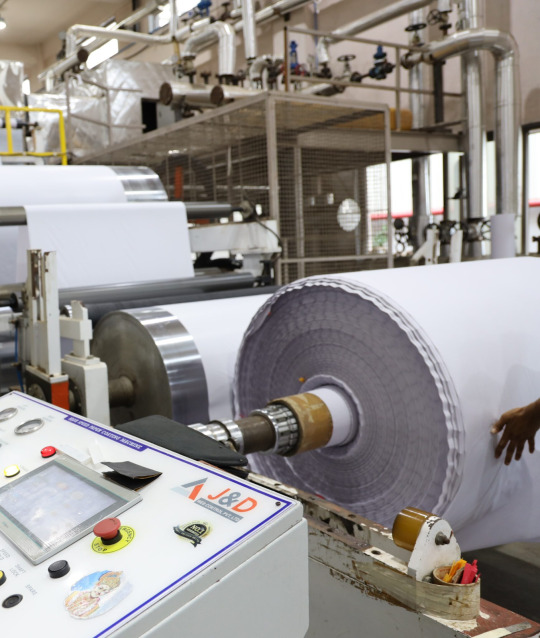
Which Printing Method is Right for You?
The choice between sublimation printing and digital textile printing depends largely on your specific needs and the type of product you're creating. If you're looking for vibrant prints on polyester fabrics and need a durable, long-lasting result, sublimation is the way to go. However, if you need to print on a variety of fabrics or require fine details and intricate designs, digital textile printing may be the better option.
At True Colors Group, we pride ourselves on offering both sublimation printing and digital textile printing solutions. Whether you're producing custom apparel, home textiles, or promotional products, we have the expertise and the printing machines to bring your vision to life.
Conclusion
Both sublimation printing and digital textile printing have their unique strengths, and the choice between the two will depend on your project’s requirements. With True Colors Group, you can be confident that we’ll help you select the right method to achieve the best results, no matter what type of textile you're working with.
0 notes
Text
Why High-Waist Yoga Pants Are Taking Over Activewear in 2024 - 2025

The activewear industry is no stranger to trends, but few have made as significant an impact as high-waist yoga pants. These versatile, comfortable, and stylish staples are dominating workout wardrobes and everyday fashion alike. As we move into 2024 and 2025, high-waist wide-leg linen pants are set to maintain their reign, and it’s easy to see why.
The Appeal of High-Waist Yoga Pants
High-waist yoga pants offer a unique combination of comfort and functionality. Their defining feature—a high-rise waistband—provides superior coverage and support. Whether you’re holding a downward dog or running errands, these pants stay in place, offering a secure fit that’s both flattering and practical.
Another reason for their popularity is their ability to suit various body types. The high waistband creates a smooth silhouette, accentuating the waistline and elongating the legs. This makes them a go-to choice not only for fitness enthusiasts but also for those seeking comfortable yet stylish loungewear.
From Studio to Street
What sets high-waist yoga pants apart is their versatility. In today’s era of athleisure, these pants are no longer confined to yoga studios or gyms. Paired with a cropped hoodie or an oversized blazer, they seamlessly transition from workout wear to casual chic. This adaptability has solidified their position as a wardrobe essential.
High-Waist Yoga Pants vs. Wide-Leg Linen Pants
While high-waist yoga pants dominate activewear, wide-leg linen pants are gaining traction in the realm of relaxed, breathable fashion. Both styles prioritize comfort, but their purposes differ. High-waist yoga pants are designed for movement, offering stretch and support for various activities. Wide-leg linen pants, on the other hand, are ideal for casual outings or summer days, thanks to their lightweight, airy fabric.
Despite their differences, these two styles are complementary rather than competitive. Many fashion-forward individuals pair high-waist yoga pants with breezy wide-leg linen pants to create layered looks that combine sporty and relaxed vibes.
Sustainability and Innovation
Another factor driving the popularity of high-waist yoga pants is the industry’s focus on sustainability. Many brands are using eco-friendly materials such as recycled polyester and organic cotton to produce their activewear. These innovations appeal to the growing number of consumers prioritizing environmentally conscious purchases.
Additionally, technological advancements have improved the quality of high-waist yoga pants. Features like moisture-wicking fabrics, four-way stretch, and hidden pockets make them functional and durable, ensuring they meet the needs of modern lifestyles.
The Future of High-Waist Yoga Pants
As fashion continues to evolve, high-waist yoga pants will likely remain a cornerstone of activewear. Their ability to adapt to different occasions and preferences ensures they’ll stay relevant. With the rise of hybrid clothing that blends comfort and style, these pants are well-positioned to cater to fitness enthusiasts and fashion-conscious individuals.
In conclusion, high-waist yoga pants have proven themselves as more than just a fleeting trend. Their perfect balance of comfort, versatility, and style makes them a must-have for 2024 and 2025. Whether you’re breaking a sweat or embracing a laid-back look, these pants are here to stay, offering endless possibilities for every wardrobe.
0 notes
Text
Best Casual T-Shirts: How to Choose the Perfect Fit for Your Lifestyle

Casual T-shirts have become a staple in everyone’s wardrobe, transcending age, gender, and lifestyle. Whether running errands, meeting friends, or enjoying a relaxed day at home, a well-fitted T-shirt is the go-to apparel. For residents and visitors of Newry, finding the best casual T-shirts in Newry can be both a fashion quest and an opportunity to express individuality. But with countless options available, how do you choose the perfect fit? This blog will guide you through key factors when picking casual T-shirts that align with your style and lifestyle.
1. The Importance of Fit
When it comes to T-shirts, fit is everything. A poorly fitted T-shirt can make even the most stylish individual appear sloppy. Here’s how to choose the right fit:
Slim Fit: Ideal for a sleek, modern look, slim-fit T-shirts are slightly tapered at the waist and emphasise the body’s natural shape.
Regular Fit: Perfect for casual comfort, regular-fit T-shirts provide a balanced look without being too tight or too loose.
Oversized Fit: For those who prefer a relaxed, trendy vibe, oversized T-shirts are gaining popularity and are ideal for layering.
When shopping for the best casual T-shirts in Newry, always try different fits to see which style complements your body type.
2. Fabric Matters
The fabric of a T-shirt determines its comfort, durability, and suitability for various occasions. Common materials include:
Cotton: Lightweight, breathable, and soft, cotton is a popular choice for casual wear.
Blended Fabrics: Cotton blends with polyester or elastane offer added durability and flexibility, making them perfect for active lifestyles.
Linen: For warmer days, linen T-shirts provide excellent breathability and a relaxed aesthetic.
When selecting T-shirts in Newry, check the fabric label to ensure comfort and longevity.
3. Colors That Complement Your Wardrobe
Choosing the right colours is essential to building a versatile T-shirt collection. Here’s how to approach colour selection:
Neutrals: White, black, grey, and navy are must-haves as they pair well with almost anything.
Seasonal Shades: Opt for pastels in spring, earthy tones in fall, and bright hues for summer to match the season’s vibe.
Patterns and Prints: While solids are classic, don’t shy away from stripes, graphic prints, or subtle patterns to add variety to your wardrobe.
Explore local stores in Newry to find T-shirts that suit your palette and help you make a style statement.
4. Consider the Occasion
Not all casual T-shirts are created equal. Depending on where you plan to wear them, you might need different styles:
Everyday Wear: Simple crew neck T-shirts in solid colours or subtle patterns work perfectly.
Athleisure: T-shirts made with moisture-wicking fabrics are great for workouts or casual outings.
Smart-Casual: Pair a plain, high-quality T-shirt with a blazer or cardigan for a polished yet relaxed look.
When searching for the best casual T-shirts in Newry, consider the versatility of each option to get the most out of your purchase.
5. Sustainability and Ethical Choices
More shoppers are now prioritizing sustainable and ethically produced clothing. When buying T-shirts, look for options made from organic fabrics or brands that practice fair labour. By supporting sustainable practices, you contribute to a better environment and ensure the longevity of your wardrobe.
6. Price vs. Quality
While it’s tempting to opt for cheaper T-shirts, investing in high-quality options pays off in the long run. High-quality T-shirts retain their shape, colour, and texture even after multiple washes.
In Newry, many retailers offer a wide range of prices. Compare options and choose T-shirts that balance affordability with durability.
7. Local Shopping in Newry
Newry boasts a vibrant shopping scene with a mix of independent boutiques and larger retailers. Here are a few tips to make the most of your shopping experience:
Visit Local Markets: Explore local markets in Newry to discover unique and affordable T-shirt options.
Support Local Artisans: Many local designers create one-of-a-kind T-shirts that stand out.
Take Advantage of Seasonal Sales: Keep an eye out for discounts during seasonal sales to get the best deals on casual T-shirts.
8. Caring for Your T-Shirts
Once you’ve invested in the best casual T-shirts in Newry, proper care is essential to maintain their appearance and longevity. Follow these tips:
Wash Inside Out: This protects the fabric and prevents prints from fading.
Use Cold Water: Washing in cold water preserves the fabric and colour.
Avoid Over-Drying: Air-dry your T-shirts or use a low-heat setting in the dryer to prevent shrinkage.
Conclusion
Finding the best casual T-shirts in Newry doesn’t have to be overwhelming. By considering factors such as fit, fabric, colour, and sustainability, you can curate a T-shirt collection that reflects your style and suits your daily activities. Whether you’re shopping for classic staples or trendy pieces, Newry offers a variety of options to cater to every preference.
Elevate your wardrobe today by choosing T-shirts that not only look great but also feel fantastic, ensuring you’re always dressed for comfort and style.
0 notes